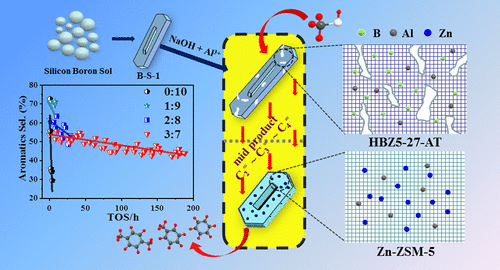当前位置:
X-MOL 学术
›
Ind. Eng. Chem. Res.
›
论文详情
Our official English website, www.x-mol.net, welcomes your
feedback! (Note: you will need to create a separate account there.)
Synergistic Catalysis of Multi-Stage Pore-Rich H-BZSM-5 and Zn-ZSM-5 for the Production of Aromatic Hydrocarbons from Methanol via Lower Olefins
Industrial & Engineering Chemistry Research ( IF 3.8 ) Pub Date : 2020-11-11 , DOI: 10.1021/acs.iecr.0c05225 Chengyi Dai 1, 2 , Kang Du 1 , Zhongshun Chen 1 , Huiyong Chen 1, 2 , Xinwen Guo 3 , Xiaoxun Ma 1, 2
Industrial & Engineering Chemistry Research ( IF 3.8 ) Pub Date : 2020-11-11 , DOI: 10.1021/acs.iecr.0c05225 Chengyi Dai 1, 2 , Kang Du 1 , Zhongshun Chen 1 , Huiyong Chen 1, 2 , Xinwen Guo 3 , Xiaoxun Ma 1, 2
Affiliation

|
In this study, a series of H-BZSM-5 catalysts, rich in porous structures, were prepared by a template-free method followed by an alkali treatment, each of which was combined with a Zn-ZSM-5 catalyst to produce aromatic hydrocarbons from methanol via low-carbon olefins. By separately designing suitable catalysts that satisfy the needs of these two stages, and appropriately matching these two catalysts, the stability of the catalyst and single-pass aromatic production is expected to improve. For two-step coupling to produce aromatic hydrocarbons, the HBZ5-x-AT catalyst (H-BZSM-5 treated with NaOH + Al(NO3)3) was selected for the conversion of methanol to low-carbon olefins. Adding an appropriate amount of aluminum during the alkali treatment can suppress the over-etching of the silicon-rich region inside the crystal and, at the same time, aluminum atoms and boron atoms undergo isomorphous substitution. While introducing continuous mesopores, some strong acid sites are introduced, significantly improving the stability of B-ZSM-5 in the methanol-to-olefin (Step 1) reaction. The HBZ5-27-AT catalyst has a suitable catalyst lifetime, high C2=–C4= intermediate product selectivity, with a total selectivity of 73%, which is beneficial to subsequent olefin aromatization. The Zn-ZSM-5 catalyst was selected for the preparation of aromatics from low-carbon olefins (Step 2). Considering the effect of the composite method and ratio of the two kinds of catalysts on the performance of the two-step coupled aromatic production, it is concluded that, when the composite catalyst has upper and lower layer filling and the ratio is 3:7, compared with the traditional Zn-modified ZSM-5, the stability of the catalyst was increased from 3 to 194 h, and the single-pass aromatic production increased from 0.15 to 4.98 g/g catalyst.
中文翻译:

多阶段富孔H-BZSM-5和Zn-ZSM-5的协同催化,用于通过低级烯烃从甲醇生产芳烃
在这项研究中,采用无模板方法,然后进行碱处理,制备了一系列富含多孔结构的H-BZSM-5催化剂,每种催化剂均与Zn-ZSM-5催化剂结合使用以生产芳烃通过低碳烯烃从甲醇中提取。通过单独设计满足这两个阶段的需要的合适的催化剂,并适当地匹配这两种催化剂,可以期望提高催化剂的稳定性和单程芳族生产。对于两步偶联以生产芳烃,HBZ5- x -AT催化剂(H-BZSM-5用NaOH + Al(NO 3)3处理)选择)以将甲醇转化为低碳烯烃。在碱处理期间添加适量的铝可以抑制晶体内部的富硅区域的过度蚀刻,并且同时,铝原子和硼原子经历同晶取代。在引入连续的中孔时,引入了一些强酸位,从而显着提高了B-ZSM-5在甲醇制烯烃(步骤1)反应中的稳定性。HBZ5-27-AT催化剂具有合适的催化剂寿命,高C 2 = –C 4 =中间产物选择性,总选择性为73%,这对随后的烯烃芳构化很有帮助。选择Zn-ZSM-5催化剂从低碳烯烃制备芳烃(步骤2)。考虑到复合方法和两种催化剂的比例对两步偶联芳烃生产性能的影响,得出的结论是,当复合催化剂具有上,下层填充时,比例为3:7,与传统的Zn改性ZSM-5相比,催化剂的稳定性从3小时提高到194小时,单程芳烃的生产量从0.15 g / g催化剂提高到4.98 g / g。
更新日期:2020-11-25
中文翻译:

多阶段富孔H-BZSM-5和Zn-ZSM-5的协同催化,用于通过低级烯烃从甲醇生产芳烃
在这项研究中,采用无模板方法,然后进行碱处理,制备了一系列富含多孔结构的H-BZSM-5催化剂,每种催化剂均与Zn-ZSM-5催化剂结合使用以生产芳烃通过低碳烯烃从甲醇中提取。通过单独设计满足这两个阶段的需要的合适的催化剂,并适当地匹配这两种催化剂,可以期望提高催化剂的稳定性和单程芳族生产。对于两步偶联以生产芳烃,HBZ5- x -AT催化剂(H-BZSM-5用NaOH + Al(NO 3)3处理)选择)以将甲醇转化为低碳烯烃。在碱处理期间添加适量的铝可以抑制晶体内部的富硅区域的过度蚀刻,并且同时,铝原子和硼原子经历同晶取代。在引入连续的中孔时,引入了一些强酸位,从而显着提高了B-ZSM-5在甲醇制烯烃(步骤1)反应中的稳定性。HBZ5-27-AT催化剂具有合适的催化剂寿命,高C 2 = –C 4 =中间产物选择性,总选择性为73%,这对随后的烯烃芳构化很有帮助。选择Zn-ZSM-5催化剂从低碳烯烃制备芳烃(步骤2)。考虑到复合方法和两种催化剂的比例对两步偶联芳烃生产性能的影响,得出的结论是,当复合催化剂具有上,下层填充时,比例为3:7,与传统的Zn改性ZSM-5相比,催化剂的稳定性从3小时提高到194小时,单程芳烃的生产量从0.15 g / g催化剂提高到4.98 g / g。











































 京公网安备 11010802027423号
京公网安备 11010802027423号